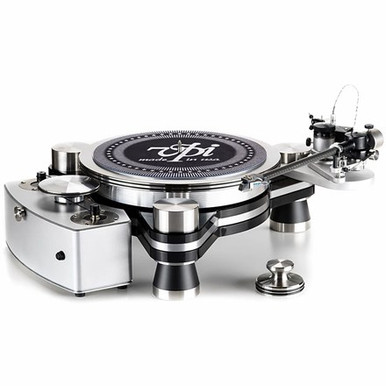That is because you are polite and I am not. I see no reason to support an inferior mounting system whether it works OK or not. The cartridge generates a voltage with relative movement of the stylus to the body of the cartridge. It does not matter which element is moving. It is hard enough to control one element. With an outboard tonearm mount you now have to control three, the turntable, the tonearm piler and whatever it is they are sitting on. With the preferred method only one, the turntable chassis which is very easy to isolate.
Vibration Question
Warning to the sensitive: involves tonearm pods.
I know this topic is beyond the pale to some, but my tables cannot take a second tonearm (once upon a time, though, they did), and I enjoy variety in cartridges. I have bought four pods so far from Lee Drage at Acoustand, two plain and two with built in micrometer VTA adjustment. But I discover the airspace around the tables is too congested with six arms, as well as introducing some grounding issues. So, as I told pindac the other day, I started to experiment with using two pods per tonearm. Not just a simple 'if one is good then two must be better' but for practical reasons. Firstly, a pod resting on three spikes weighs about 10lb, but it doesn't take much pressure on the distal end of the arm panel to cause it to tip. One can spoil a carefully set up alignment that way, and if it continues tipping a disaster could happen. So, I thought, why not place a pod under the distal end of the tonearm panel, and prevent that happening?

But then a second thought came along: if the second pod were firmly coupled to the panel, I would double mass and damp vibrations even more. That's a bit theoretical to me, as my oak chest weighs ~350lb and I can stamp on the floor next to it and not disturb a playing stylus. But rigidity is rigidity. So I asked Lee if he could make me a double ended panel with an SME mount centred in the middle. Roughly, like this:

He agreed, and pointed out I would have to forego the VTA adjustment, unless one were to place a screw at each end! I can use the SME mount itself to adjust VTA. though, so that's OK.
Here, finally is the question: he thinks I am simply introducing twice as many vibrations (external, I think he means) into the tonearm by having it rest in two sites on the oak chest, and that I would be better off having one end of the tonearm panel free-floating. My view is that rigidity is paramount, and if a built-in tonearm on a table is firmly coupled to the table then I am moving a bit closer to that ideal by having a firmly coupled chest-table-pod system. What say you?
- ...
- 35 posts total
I see the dominant opinion is, as expected: don't use pods at all. But given the turntables I have (where there is no other choice), I shall ask once more, is a tonearm better off on a single pod, or a double pod? The latter doubles the mass coupled to the tonearm, but possibly provides two routes for vibration to be transmitted to the tonearm instead of one. I'm doing it anyway, so don't feel you have to advise me carefully in that respect. I just want to get a feel for whether you think there is any merit in the argument that more external vibrations will be transmitted, and if so, they will outweigh (!) the doubled mass? I expect there isn't much of a body of knowledge on this, but I'm curious as to your thoughts. |
@mijostyn For once I am in agreement. I have said it. elsewhere in this forum. Even the pivoting leaf type of mount found on many turntables such as this one is significant compromise. It offers versatility if you change tonearms and easy adjustment of P-S and yet at the same time invites detrimental vibration. One of the most knowledgeable guys in the industry who builds plinths admitted as much to me at Axpona one year. VPI has been designing turntables with aluminum bridges upon which the tonearm sits to facilitate their VTA on the fly adjustment system for many years, again a compromised design. The ultimate effect on performance may approach the minuscule, but at the price level asked it is not appropriate. SME has the best approach to adjustable P-S-the rock solid "sliding sled". All of this is just my humble op.
|
What says me is that you should ditch the oak chest and replace it with a more dense, mass-loaded, and precisely flat base and then use one very dense and massive tonearm pod. The concurrent thread about the OMA audio turntable designs demonstrates this approach.
|
- 35 posts total



